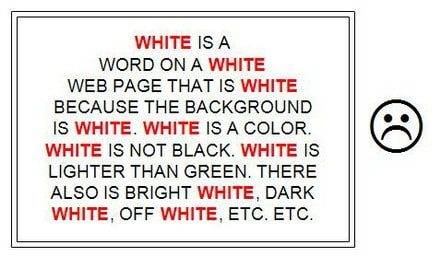
8 Outdated SEO Tactics That You Should Retire
If you are in the herd of improving your SEO strategies and skills to move the needle even more for your organization and clients, then you are at the right place.
Right now, it’s time to ditch the lousy SEO tactics and start inculcating new ones or enhancing existing ones.
I know we are typically expressive toward specific areas of SEO like technical, on-page, off-page, etc. based on the interests or familiarity, but we never focus thoroughly on SEO strategies.
Our focus is limited.
Here’s is the key to building effective SEO strategies by retiring old-school tactics that will help you broaden your scope of context and content-driven SEO without breaking a sweat.
— Keyword stuffing —
Back then, search engines weren’t as complex, and keyword stuffing worked brilliantly.
Many sites used to stuff dozens of keywords throughout their content. The only issue with such keywording is it’s aberrant nature because it was only being utilized to improve the search relevance of the page.

Img source: https://technicallyeasy.net/wp-content/uploads/2012/08/keyword-stuffing.jpg
But now the time and search engines have upgraded, and such tactics are currently collecting dust. Nowadays, it is considered a sign of low-quality content. Moreover, you can probably be penalized for keyword stuffing as well.
“A recent study from a well-known marketing analytics software provider showed the most important ranking factors are direct website visits, session time, and bounce rate. While keywords rank at the bottom of the list, currently, they’re not nearly as effective as they were used to be.”
It doesn’t mean that you should completely neglect keywords in your content, but you need to ensure that you avidly use the keyword so that your content look natural and less of an advertisement.
It is much better to generate valuable content with fewer keywords rather than low quality content with too many of them.
It is much better to generate valuable content with fewer keywords rather than low quality content with too many of them.
— Overlooking local SEO —
The biggest fallacy in context to SEO is that to always focus on the bigger picture.
Many companies are just pleasing mass audience to get traffic and ranking but forgetting their actual target consumers.
It is especially crucial for businesses based in particular locality to prioritize traffic from people in that area. Getting traffic from people who are never going to use your service is just a waste of time and money.
We know that web traffic plays a pivotal role in improving site ranking, but local SEO is much more beneficial for the local business regarding reach and revenue.
Various businesses like medical services, restaurants, law firms, pet adoption centers, real estate, etc. who provide their services in a particular area or city receive a massive benefit from local SEO.
“Around 88% of customers who searches local business on a mobile device either call or visit the store within 24 hours.”
Such advantages suggest that ignoring local SEO can be a big mistake for any business.
— Exact Match Domain —
The time had long gone when exact match domain (EMD) was a hot topic in the landscape of SEO. This tactic was favorite among various marketers to elevate the ranking of their website in the search engine. It was so effective that you could see the difference in the ranking in just a couple of days.
As the name implies, the central idea of the EMD is to create a website that is identical to the keyword that people target.
For example, cheapshirts, personalizedcakeshop, atlaschiromaine, etc.
This method is useful, but sometimes you may end up in a spammy website. Besides, the relevant sites that you are looking for may get overshadowed, and you have to scroll halfway down to see the legitimate websites.
Due to such detrimental effect on the search engine, Google is still upgrading their algorithms to eradicate such spammy EMD websites so that people can get precise information.
Moreover, EMD can never help you build a brand. Just say, if Saavn has used this technique and named their domain like “listenfreesongs.” It won’t have received such great hype. Such keywords are not brandable. Hence it makes the strategy less trustworthy and difficult in building links.
It is always better to say goodbye to such tactics and use the brandable name to enhance your exposure.
— Non-hierarchical architecture —
Having a good hierarchy in your website can help the visitors in navigating from one page to another.
With the increase in the use of WordPress for website development, it has created a problem in navigation as by default they set up the URL of the pages like:
www.yourname.com/page1
It looks simple and easy for people to access but increases the difficulties for the SEO managers. It makes it hard for the search engines to understand the structure of the website. Moreover, your rating can degrade as the bots, and SEO crawlers will not rate the page with the same level of importance.
It is essential that the search engines understand the primary aspects of each page and the relationship with other pages. Creating a hierarchy and removing the flat URL can help the search engine to understand your website easily so that you can gain more organic traffic.
— Irrelevant guest posting —
Guest blogging is an effective method to build links and target potential clients, but you need to be careful while doing it. Publishing irrelevant posts won’t aid you.
It is vital that you use guest blogging sites with precision to increase exposure for your brand. It will allow you to reach a new audience that falls within your target market. That’s only possible by publishing relevant content.
“For example, if a person is a content marketer, then he/she has no business submitting his/her posts to automobile magazines. It’s irrelevant to his/her brand, website, and target audience. 73% of consumers get irritated when they receive inappropriate web content.”
Furthermore, Google will identify such irrelevant links and potentially punish both parties for posting. Always check the relevancy of the post when managing guest articles on your site as well.
— Buying or selling links —
It is the common but most detrimental SEO tactic that you should think twice about before incorporating. The technique looks fascinating but it’s devil in disguise.
You must have heard about buying links to boost the website search engine ranking. Such method was much prevailing in the early 2000s, but in present situations, many reputed marketing agencies shunned such activities.
“The recent example of buying/selling links came when a large departmental store chain was caught red-handed for purchasing a large number of keywords that target a range of keywords. Such activity ruined their ranking, and they have to remove the links that they have bought. It took them some time to see the improvement in their ranking.”
In addition, Google has never favored the use of buying links to rank higher, and in the recent past, they have shut down many sites who were indulged in such black hat SEO tactic.
The reason was simple, to earn higher ranks in an organic result, it is essential for you to have some quality content that can bind the readers to your website, but it is unethical to buy a bunch of links to gatecrash your ranking spuriously.
— Giving importance to quantity rather than quality —
A good old saying of Hippocrates, “Nothing in excess is good” works well with the digital marketers. Some businesses are always in a hurry in publishing new content every day which is not only useless but are also of a low-quality.
It is much better to work at our own pace while creating the content without letting the quality suffer.
Advancement in algorithms and site crawlers allow them to identify poor quality and high-quality content easily.
The quality is getting more important nowadays, having a small informative blog is much better than a long blog. But that doesn’t mean that’s you have to publish sweet and short posts. Longer blog posts still have its charm and are steadily gaining popularity every year.
“A study conducted by web-based research lab elicits that long articles outperformed the short post by 40.54% and generate more ROI when the content is compelling.”
To be honest, it is always recommended to go for longer posts over shorter as some topics can only be appropriately expressed when we have the liberty of words.
— Content scams —
Another unnatural black hat SEO technique is the content scam. It was popular in the early days of SEO due to the lack of proper search engine algorithms but now it should be avoided. Here are some examples of content scams:
-
Duplicate content : It is a way to plagiarize the content from one or more website. It was prevalent in the past, but the history is long gone.
-
Article spinning : When the articles are taken from the original website, but to avoid duplicity, people rewrite the content to outwit the problem of plagiarism.
Such things can be done quickly through manual or automated efforts. But the problem with automation is that it produces low-quality content that may have a high risk of being duplicate.
The problem with this technique is that it can dwindle your ranking quickly and you may get a penalty from Google Panda. It is always better to use a plagiarism software so that you stay away from such scams.
Bottom Line
SEO is evolving at an accelerated pace so it’s better we also move with it and enjoy the sweet fruits it bears for us.
If you are the one still incorporating these tactics and wasting your time, then it’s time to put these tactics in a shelf and start implementing new techniques.
The strategies mentioned above may give you the glory quickly, but it is just a matter of time when you will pay for it.

